On the Track of the Kumbway
Posted by: Loren Coleman on December 30th, 2007
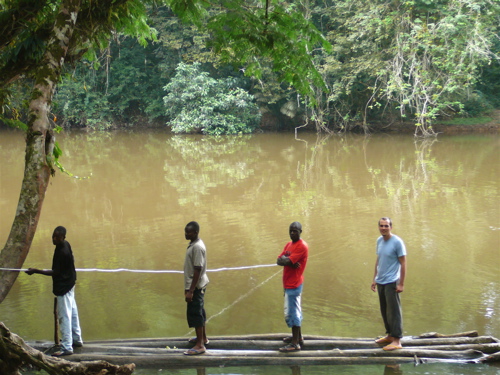
John-Mark Sheppard (above, right), writing from Liberia, shares the following information about another armored cryptid as yet unrecorded in the cryptozoology literature.
Although Sheppard speaks below in terms of the “reptilian” nature of this cryptid, the reported appearance of hairs might point to the mammalian origins for these reports, e.g. Pholidota: the pangolins (shown in the two images below). However, such an answer does not address all the issues raised by the descriptions given of the Kumbway.
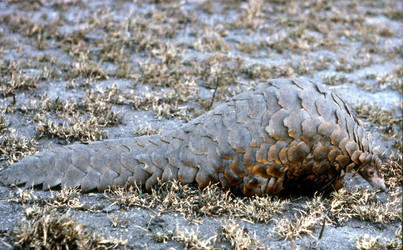
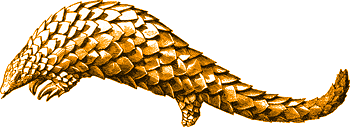
John-Mark’s report follows:
There is a Liberian cryptid known in the Mende language as Kumbway. This reptilian creature is less widely known than the Gbahali.
The Kumbway lives in swampy areas of the deep forest of Vahun District, Lofa County. The uncle of one of my staff named Samuel Carmo was a hunter in the Vahun district. In 1988 he killed one near his village of Segemah near the Sierra Leone border. He apparently had been stalking it for several days when he came across it early one morning.
When it saw him, it crouched down in the grass, leaving only its armor-like back exposed. His shotgun would have been ineffective at this point. Then animal then reared up on its hind legs to attack him. Luckily for him, he was able to shoot it in its mouth, killing it instantly. He hurried back to his village and recruited three other men to help him carry it home. An old man in the village remarked that these creatures were more common in the past, but had become very rare in the recent years. They then butchered the animal and the villagers, including Samuel, ate it.
Samuel described the animal as being between 15-20 feet long. One of its most notable features is the thick armor-like plating on its back with a distinct brown and black pattern. There also is a row of 1/2” serrated spines running down its back to the end of the tail. In contrast to its heavily protected back, the underbelly is soft and is covered with a whitish hairs about an inch and a half in length. These hairs can also be seen on its snout. The teeth are very large (about the size of a man’s thumb).
The Kumbway has powerful hind legs which allow it to rear up occasionally. They are said to be ambush predators, their diet probably consisting primarily of ground hogs and small forest antelope. The legs extent straight underneath the belly, in contrast to lizards and crocodiles. They have thick, powerful claws that allow them to dig large borrows, probably in which to lay its eggs. Other animals like giant pangolins may take up residence in these borrows after they are abandoned by the kumbway.
I actually visited the village on a recent survey trip for my program, but the uncle had left for Sierra Leone, and had not been seen for two months. I hope to return there in the coming months to interview him personally about this animal.
As for actually seeing one of these creatures with my own eyes; that is extremely unlikely. It would be like finding a needle in the proverbial haystack. The forest in which they live also contains other large animals such as forest buffalo, pigmy hippos, leopards, and elephants; yet one could go for weeks in the forest without seeing any of these well-documented animals. The area is very large and the forest is extremely dense.
Recently I was able to take a UN helicopter to travel from Lofa to Monrovia. As we flew over Liberia’s seemingly endless rainforest, with its cloud covered mountains (below), and its winding rivers meandering under the forest canopy (below), I was reminded again of how much of Liberia remains to be explored. Who knows what is still out there waiting to be discovered? ~ John-Mark Sheppard, in personal correspondence to Loren Coleman, December 2007.
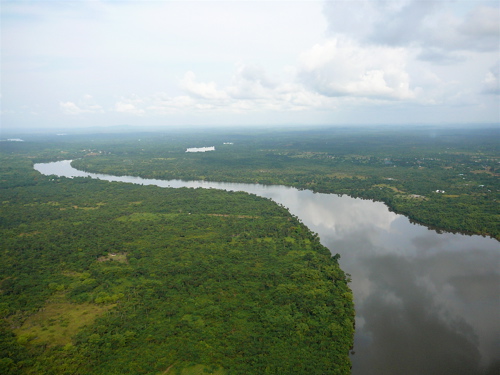
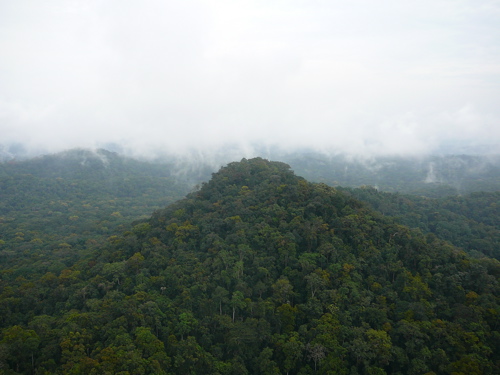
About Loren Coleman
Loren Coleman is one of the world’s leading cryptozoologists, some say “the” leading living cryptozoologist. Certainly, he is acknowledged as the current living American researcher and writer who has most popularized cryptozoology in the late 20th and early 21st centuries.
Starting his fieldwork and investigations in 1960, after traveling and trekking extensively in pursuit of cryptozoological mysteries, Coleman began writing to share his experiences in 1969. An honorary member of Ivan T. Sanderson’s Society for the Investigation of the Unexplained in the 1970s, Coleman has been bestowed with similar honorary memberships of the North Idaho College Cryptozoology Club in 1983, and in subsequent years, that of the British Columbia Scientific Cryptozoology Club, CryptoSafari International, and other international organizations. He was also a Life Member and Benefactor of the International Society of Cryptozoology (now-defunct).
Loren Coleman’s daily blog, as a member of the Cryptomundo Team, served as an ongoing avenue of communication for the ever-growing body of cryptozoo news from 2005 through 2013. He returned as an infrequent contributor beginning Halloween week of 2015.
Coleman is the founder in 2003, and current director of the International Cryptozoology Museum in Portland, Maine.










This is a very interesting creature. I believe there are many more animals and reptiles out there that we don’t even know about.
There was no mention as to what time of day this Kumbway was captured. I’d be interested to know if it appears to be a nocturnal animal as well as the Pangolin. Something else that’s fascinating to me is the mention of the laying of eggs. Would that possibility, along with the spcaly/spiny description make this creature a relative of the monotreme?
This creature seems to blend in to its surroundings. I did not notice it even had a face.
It is very strange that these unknown or fictional animal in Africa are ALWAYS seen, hunted, killed, and eaten by someone who can’t be found at the time of the report. The village could be set up for life if they would just save the bones or any small piece for DNA (or even better the killed animal) but, there NEVER is ANY remains or even the place where they dumped what remained after they feast on their this “unknown to science but known and eaten animal”. I always wonder if the “researcher” pays the locals for their stories of how they or usually someone they know but can’t find now saw, killed, and ate these “monsters”. Surely the “researchers” tell them that the dead animal would be worth their weight in gold.
I agree with gkingdano. It seems very convenient that, even though the animal in question was eaten, absolutely nothing remains. Did the natives use the armor scales as roughage? Were the bones boiled down to nothing for soup stock? Were the finger sized teeth used up as dental floss? There is always much said about primitive living people using all of an animal and wasting nothing. But there are always some parts of an animal which either cannot be used or which maintain their separate individuality and can be recognized for what they are. Teeth and claws like the ones described would make fine necklaces or bracelets. So would the scales, and the belly hair could be used for a skirt, blanket, what have you. Some sort of trophy should have been made to celebrate such a rare kill. Where are they?
This all goes back to the old argument of the existence of physical evidence. Without a body, or recognizable parts of a body, the stories are simply that; stories. They may be stories told by fine, upstanding and truthful people, with nothing to gain for themselves, and speaking in the most serious manner about events and creatures they personally witnessed. But without physical evidence they remain stories.
This particular event allegedly happened in 1988. Even if they had used the bones or whatever else, they would very likely be long gone by now. And in general, many native people don’t recognize these animals as being unique or valuable to science nor do they even care. The only thing that is important to them is surviving. The only time they recognize the importance of the creature is when someone tells them and even then the animal in question is cited as being very rare by the native people anyway. So I think questioning the validity of the story based on the native people not having any remains is a little harsh.
My Cardiologist is from Sierra Leone, i shall inquire to see if he has any knowledge of such a beast.
A lot of people are asking the question, “if the natives really killed these animals, where’s the evidence?” There are a number of reasons why the physical evidence for these cryptids might be missing. Here are some that come to my mind:
1. People in remote areas are not aware of the scientific value of these animals. While they may be regarded as unusual, in the end they will be seen as simply another source of protein. Any part of the animal that can be eaten will be eaten. Any bones or scales not useful for cooking will likely be thrown away in dump piles on the edge of the village and quickly be covered with dirt and vegetation. Keep in mind that people in these areas have killed and eaten large animals like elephant, forest buffalo and leopard, but you would be hard pressed to find any “hard evidence” of this on a random visit to their village.
2. These incidents date before the Liberian civil war. As mentioned in the post about the gbahali, there was a skull kept in the village I visited. But it was destroyed in a fire along with the rest of the village when it was attacked by rebels. When you are running for your life, preserving animal remains is not going to be your first priority!
3. Some mentioned how researchers should let the natives know that remains of such animals would be worth their weight in gold. Obviously researchers will do all they can to collect physical evidence, but advertising a high reward would just be inviting hoaxes. In most cases the villagers are more than willing to cooperate anyway.
Thank you Mr. Sheppard for sharing your personal history and stories from Africa. Please keep us posted as to any new findings! I was surprised by the size of the Kumbway estimated at 15-20feet. Amazing.
Best to all in the new year!
I wish the reason for the drop in their numbers was mentioned.
Comment to:
An old man in the village remarked that these creatures were more common in the past, but had become very rare in the recent years.
It’s just the frustrating thing of hearing stories and not coming away with anything. I would assume they might use the armor for something around the village, but then again that’s assuming it was usable, and assuming that it had some value beyond food (like maybe shelter capabilities?), but then you know what ASSuming does.
Still very interesting, something big as 15-20 feet is sizable indeed. Pangolin like maybe?
As for their numbers, I would guess hunting might be the big reason. The article said they were ambush hunters implying carnivores, but with the big claws for burrowing, I wonder if it might be more of a herbivore. Any info on that beyond the article? I just got the impression from the information given that it may have been foraging for food.
Don’t know my pangolins either, are they carnivorous?
Just posing questions for debate and discussion 🙂
If only the edible parts of an animal are kept (something I doubt anyway), doesn’t the story about the Gbahali’s skull that tragically went destroyed along with that village suddenly lose a lot of credibility? It also seems like a contradiction to me that these assertions are coming from the same source.
The Giant Pangolin (Manis gigantea) is the largest known of the species, but it only grows to about 5 feet in length so it would be far smaller than the animal described. All of the Pangolin species are insectivores, “anteaters” if you will:they don’t have teeth, rather they use a long, sticky tongue to catch ants and termites.
Adding some confusion to this matter is the fact that in the related Bandi language “Kumbwi” refers to the giant pangolin. Pangolins are also known as “ants bear” in Liberia. They almost exclusively eat ants and termites, using their powerful claws to dig into ant nests and termite mounds. They have a long sticky tongue used to lick up insects, like an anteater. Pangolins have no teeth to speak of. The common variety is usually about three feet long head to tail. The giant pangolin is roughly twice that big, about 6-7 feet long.
But my informant was adamant that the animal he saw was NOT a pangolin. He was also involved in the search for the gbahali. Samuel describes what he saw as being like a smaller terrestrial version of the gbahali.
The reported presence of hairs on the underbelly are confusing, as hair is generally considered a mammelian trait. However some ancient reptiles such as pterosaurs were known to possess hair.
This animal sounds very strongly like a composition of pangolins (which are for example also able to walk long distances on their hind legs) and crocodiles (which have “spines” on their tail, can be very big, eat meat and can have thumb-sized teeth).
Something what is really strange is that four men were able to bring it to the village. Even at 15 feet, it would weigh around 500kg when it was a crocodile, and as a pangolin even around 900kg. It is very hard to believe that they could manage to carry it. So it was either much smaller, or this was just invented.
I understand and sympathize about the difficulties people may face during a destructive civil war. Trophy skulls are definitely way down the list of things to take with you when people with guns and no conscience show up.
But I also realize that large things get larger in memory when nearly twenty years have gone by. Research has shown that in pre-literate societies very old people tend to age 17 years in the villagers memories for each real decade which passes. Something 15-20 feet long in memory may actually have been only 8-10 feet in actuality. Not a bad size (and one closer to what four men might be able to carry), and still a cryptid, but maybe less of a monster.
Look at it this way: I have a cousin who is obsessed with catching a world record blue catfish in the Tennessee River. On a couple of occasions he has landed fish that came close to the world’s record, but didn’t quite make it. On another couple of occasions he tells me that he ALMOST landed fish which would have been easy world records, but the line broke, or something else went wrong and the fish got away. I believe him, because he is a truthful man and this is too important to him to lie about. But he still doesn’t have his world record, because he has no physical proof. I can’t see that its harsh or unreasonable to want as much physical proof about African, or any other sort of cryptid, as the fishing world demands to declare a new world’s record.
I believe that this cryptid could have been 10-15′ long. Mr. Shepard mentions in his first post that villagers are capable of killing elephants, as well as other large animals.
Hauling an animal as large as an elephant lends to the presumptions that:
1) the animal has been butchered on site and
2) the villagers are smart enough to use tools involving leverage, pulleys, or dragging regardless of how primitive.
These people have no gain in our culture by making such a story up.
Then Matia points out the credibility of the story. I definitely agree with the thought that the head would be left behind, until I remember that certain tribes (primitive and not so primitive) all over the world find brains to be a delicacy. Could this have been the case involving the trophy head? Or better yet, the fact that a head is also a ‘trophy’ may be enough reason to keep the skull.
Thanks to Charlie23 on the eating habits of pangolins, and Sordes–I’m glad you brought up the point about hauling something that big back.
Now Subvertia had good points to and that could account for very little bone structure remaining if they butchered on site and left the carcass in the wilds.
The points about the back spines is another good observation, because pangolins definitely do not have those types of protrusions and leads me to believe that it is indeed something else and not pangolin related, especially if the thing is really some kind of ambush predator.
I guess the bottom line, is this is intriguing but not much to go on other than organizing more expeditions to try to track the thing down or find more people with info and possible trophies.
Good luck John-Mark Shephard! Hope you find something because this thing sounds really cool, I for one hope that it is more than a myth or exaggerated pangolin. 🙂
I guess maybe I jumped too soon, but it still seems so easy for reports of fantasically large animals (world wide ) to be killed and then there is NO physical evidence. I TRUELLY want these animals (if real) to be brought to science and then protected from being eaten or killed for sport. I know that there are many large animals that are ” not known ” to science but KNOWN to the local inhabitants, they just need to understand that the remains after their feast need to be shown to the local authorities or foreign aid workers.
Good luck with your further searches into this. I’m always fascinated to read these types of stories. They excite the romantic in me that “beasties” like this are still out there and locked in combat with the locals. Right on (!) for the post and please keep us posted! THANKS!
Did the armor plating remind the man that hunted the Kumbway of a pangolin? It’s armor looks more like scales. Or was it more like the front and back plating of an armadillo in the U.S.?
My informant described the armor plating on the Kumbway as being similar to a crocodile’s scutes, but harder. He said the only way his uncle was able to kill it is because he shot it in the mouth. Even a shotgun wouldn’t do much to this creature’s armor apparently.
Thanks for your quick response.